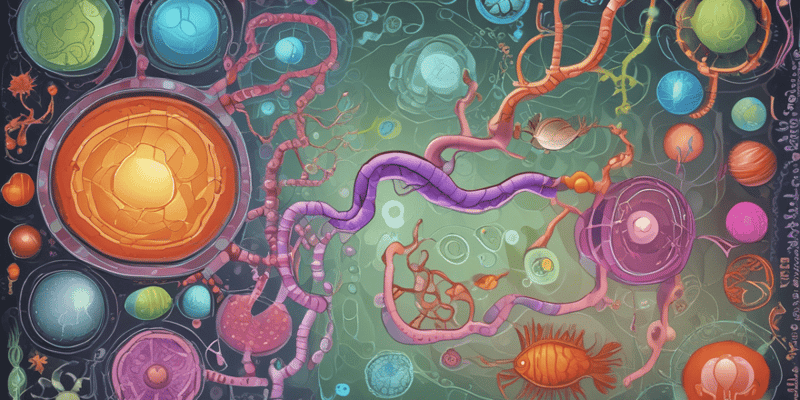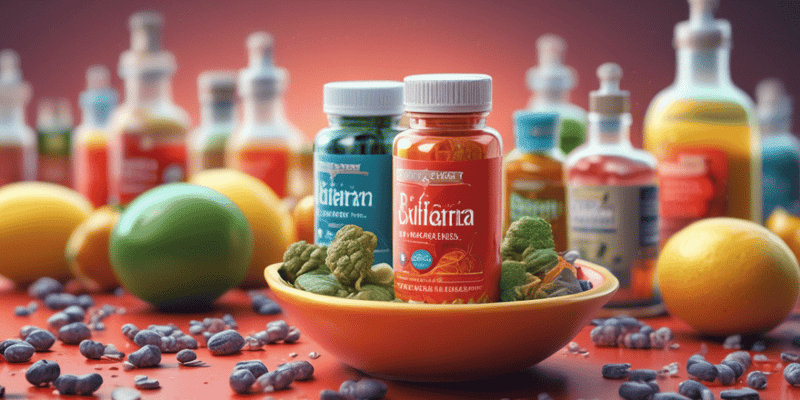30 Questions
What is the purpose of the reaction catalyzed by glutathione peroxidase?
To remove H2O2 and prevent oxidative damage to the cell membrane
What is the role of NADPH in the reaction catalyzed by glutathione peroxidase?
It is not involved in the reaction
What is the result of excessive glucose-6-phosphate production from fructose metabolism in the liver?
All of the above
What is the product of the reaction catalyzed by UDPGlc dehydrogenase?
UDP-glucuronate
What is the fate of much of the fructose metabolized in the liver?
Gluconeogenesis
What is the common feature between the HMPP and the uronic acid pathway?
Both are alternative oxidative pathways for glucose that do not lead to ATP formation
What is the enzyme responsible for the phosphorylation of galactose?
Galactokinase
What is the reactant that forms uridine diphosphate glucose (UDPGlc) in the uronic acid pathway?
Glucose-1-phosphate
What is the product of the UDPGal 4-epimerase enzyme?
UDPGlc
What is the function of the enzyme UDPGlc pyrophosphorylase in the uronic acid pathway?
It catalyzes the formation of uridine diphosphate glucose (UDPGlc)
Why is galactose not considered a dietary essential?
Because it can be synthesized from glucose
What is the purpose of galactose in the body?
Formation of lactose and glycolipids
What is the condensation product of UDPGal and glucose in the synthesis of lactose?
Lactose
Which glycosphingolipid is predominant in extra-neural tissues?
Glucosylceramide
What is the principal sialic acid found in human tissues?
Neuraminic acid
What is the consequence of genetic defects in glucose-6-phosphate dehydrogenase?
Erythrocyte hemolysis
What is the backbone of glycosphingolipids?
Sphingosine
Which type of glycosphingolipid is characterized by the presence of one or more molecules of sialic acid?
Ganglioside
What is the underlying cause of hemolytic anemia in individuals with favism?
Inherited defect in glutathione peroxidase
What is the consequence of loading the liver with fructose?
Hypertriacylglycerolemia and hypercholesterolemia
What is the role of NADPH in erythrocytes?
To supply glutathione peroxidase with reducing power
What is the consequence of increased de novo purine synthesis in the liver?
Hyperuricemia and gout
What is the nutritional status that can be assessed by measuring erythrocyte glutathione reductase and its activation by FAD?
Vitamin B2 (riboflavin) deficiency
What triggers hemolysis in individuals with favism?
Oxidative stress from infection, drugs, or fava beans
Which of the following tissues is insulin-sensitive?
Liver
What is the enzyme responsible for reducing glucose to sorbitol?
Aldose reductase
What is the consequence of sorbitol accumulation in the lens of diabetic patients?
Cataract
What is the role of NAD+ in the sorbitol pathway?
Oxidizes sorbitol to fructose
Why does sorbitol accumulation occur in diabetic patients?
High blood glucose concentrations
What is the consequence of sorbitol accumulation in the peripheral nerves of diabetic patients?
Neuropathy
Study Notes
Glutathione and Glucose-6-Phosphate
- Glutathione removes H2O2 in a reaction catalyzed by glutathione peroxidase, which contains selenium analog of cysteine (selenocysteine) at the active site.
- This reaction is important to prevent the accumulation of H2O2, which can decrease the life span of erythrocytes by causing oxidative damage to the cell membrane, leading to hemolysis.
Uronic Acid Pathway
- In the liver, the uronic acid pathway converts glucose to glucuronic acid, ascorbic acid, and pentoses.
- This pathway is an alternative oxidative pathway for glucose that doesn't lead to ATP formation.
- Glucose-6-P is isomerized to glucose-1-P, which then reacts with uridine triphosphate (UTP) to form uridine diphosphate glucose (UDPGlc) in a reaction catalyzed by UDPGlc pyrophosphorylase.
- UDPGlc is oxidized at carbon 6 by NAD-dependent UDPGlc dehydrogenase in a two-step reaction to yield UDP-glucuronate.
Fructose Metabolism
- Fructose can be degraded by glycolysis or lead to excessive fatty acid synthesis and cholesterol synthesis in the liver.
- The liver packs these lipids into VLDL and releases them into the circulatory system, resulting in hypertriglyceridemia.
- VLDL will turn into LDL in the circulation, resulting in hypercholesterolemia.
- Fructose can also be a substrate for gluconeogenesis, which is the fate of much of the fructose metabolized in the liver.
- Excessive glucose-6-phosphate production activates the pentose phosphate pathway, increasing ribose-5-phosphate and consequently increasing nucleic acid synthesis, leading to hyperuricemia and gout.
Galactose Metabolism
- Galactose is needed for the synthesis of lactose, glycolipids, proteoglycans, and glycoproteins.
- Galactokinase catalyzes the phosphorylation of galactose.
- UDPGal is produced by galactose-1-phosphate uridyl transferase enzyme.
- UDPGal is then converted to UDPGlc by UDPGal 4-epimerase enzyme.
- UDPGlc is incorporated into glycogen.
- The epimerase reaction is freely reversible, so glucose can be converted to galactose, and galactose is not a dietary essential.
Membrane Lipids
- Glycosphingolipids (GSLs) have a sphingosine backbone and are ceramide derivatives.
- Cerebrosides are a type of glycosphingolipid, with a monosaccharide part (glucose or galactose).
- Gangliosides are complex glycosphingolipids derived from glucosylceramide, containing one or more molecules of sialic acid bound to galactose or N-acetyl galactosamine.
- Neuraminic acid is the principal sialic acid found in human tissues.
Clinical Aspects
- Impairment of the pentose phosphate pathway leads to erythrocyte hemolysis due to genetic defects of glucose-6-phosphate dehydrogenase, resulting in hemolytic anemia.
- Glutathione peroxidase is dependent on a supply of NADPH, which in erythrocytes can only be formed via the pentose phosphate pathway.
- Measurement of erythrocyte glutathione reductase and its activation by FAD is used to assess vitamin B2 (riboflavin) nutritional status.
- Loading of the liver with fructose may disrupt serum lipid profile and cause high uric acid concentrations, leading to hypertriacylglycerolemia and hypercholesterolemia.
- Fructose and sorbitol are associated with diabetic pathologies, including cataract, neuropathy, and renal insufficiency.
Learn about the reactions involving glutathione and uronic acid, including the role of glutathione peroxidase and the malic enzyme in generating NADPH. Understand the importance of these pathways in preventing oxidative damage and hemolysis.
Make Your Own Quizzes and Flashcards
Convert your notes into interactive study material.
Get started for free


